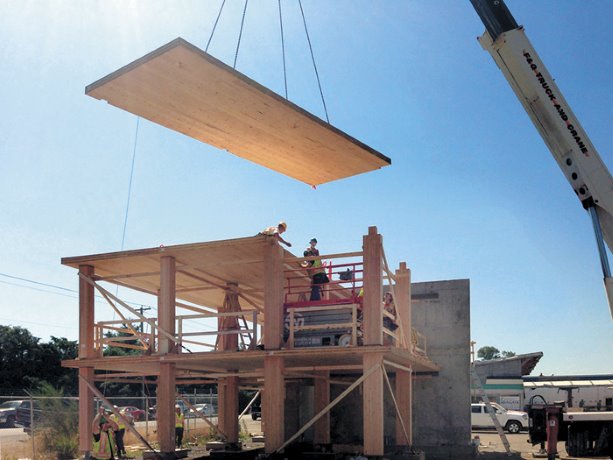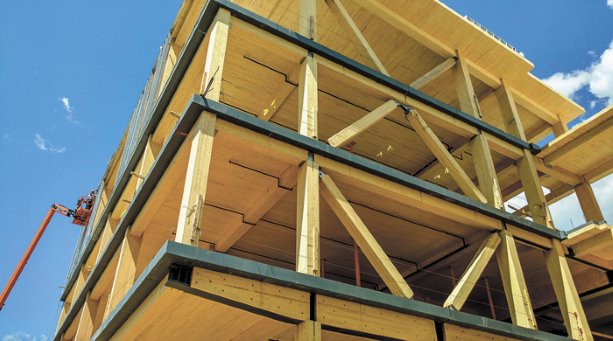New and creative ways of making and using structural wood mean the material is becoming familiar even to observers from outside the construction industry.
“With more CLT [cross-laminated timber] and other mass timber products becoming available, wood will certainly be used in more applications in the near future,” said Ian Boyle, principal of Fast + Epp, Vancouver-based structural engineers.
But the growing enthusiasm for wood should be seen in perspective.
“Wood construction is a tradition in Canada that goes back centuries,” said Michael Green, principal of Michael Green Architecture in Vancouver.
Until about 100 years ago, early structural materials were stone and masonry, with wood used mostly for roofs and floors on bigger buildings, says Robert Jackson, project engineer with Fast + Epp.
“Wood began to be used for structural purposes around the turn of the last century, when dimension lumber could be produced cheaply and efficiently using industrial methods,” Jackson said.
“Wood has a number of advantages over other structural materials, including that it’s the most sustainable.”
There is an increasing us of structural wood being used in institutional-commercial-industrial (ICI) construction, says Lynn Embury-Williams, executive director of WoodWorks BC, one of five programs of the Canadian Wood Council.
“Building codes have started to accept the use of more wood in large structures,” Embury-Williams said.
Structural wood is particularly advantageous in mid-rise structures (five to six storeys high), she says.
“Wood-frame structures go up quickly,” Embury-Williams said. “And it will become less expensive to use structural wood on taller buildings when there is more desire to develop a supply chain. There’s a big opportunity here.”
She also says structural wood on tall buildings can be used as a model for affordable housing, which is sorely needed in many Canadian cities.
Structural wood has unlimited ability to replace other construction materials in ICI applications, says Russell Acton, principal of Acton Ostry Architects Inc. in Vancouver.
“Structural wood in mixed-use residential projects can be economical,” said Acton. “Although they’re limited to six storeys in BC now, it could be possible for them to go higher the next time the building code is changed in the province, probably in 2020 or 2021.”
Acton says structural wood enables architects to design community and public institutional buildings that are both economical and functional.
“In addition, wood gives public buildings an intangible feeling of warmth and accessibility,” said Acton.
Despite the recent interest in structural wood, the actual benefits of using the material depends on the unique requirements of a project, says Jana Foit, an architect in the Vancouver office of Perkins + Will.
“There are many questions that need to be answered before deciding to use structural wood,” said Foit.
“Is there value in accelerating the schedule of the project, which using structural wood can do? Is there value in sustainability, to which structural wood can contribute? What is the effect of location of the project? Can structural wood be transported to the building site economically?”
Lest we forget, in addition to wood, concrete and steel are other widely used structural materials.
“Concrete is very durable,” said Charles Kelly, president of Concrete BC (formerly BC Ready-Mixed Construction Association).
“It’s designed to last for a long time. It might cost more, but it will hold its value for a long time, too.”
Concrete has environmental advantages too, Kelly says.
“Concrete saves energy use over the long run,” he said. “It doesn’t require a lot of insulation. And concrete is fire-resistant. It can exceed, not just meet, building code requirements.”
In addition, concrete doesn’t rot while it is being built and after it is in place it provides effective noise suppression.
Structural steel, for its part, has a strong environmental record, says Tareq Ali, spokesman for the Canadian Institute of Steel Construction.
“Structural steel has a recyclable rate of more than 90 per cent,” Ali said.
“It is infinitely recyclable. It can be used in the same application over and over again. And when it’s recycled, it doesn’t lose its structural integrity.”
In addition, Ali says, steel is durable.
“A steel building will last more than 100 years,” he said. “It has a high strength-to-weight ratio, which helps make it resilient in extreme weather, such as seismic events.”
Looking ahead, Vancouver architect Michael Green sees a major disruption coming in the construction industry.
“Construction is the only remaining major industry that still follows craft principles,” he said.
“That will change. In the future, buildings will be built in factories. Highly-customized designs will be fabricated off-site and assembled quickly on-site.”
Green says wood is light and ideal for such a system of construction.
“What is coming is the Amazon of construction,” he said.
“And it will lower the cost of housing by 30 per cent.”
Green also foresees entire structures being built with 3D printing.
“In the future, we’ll be able to print innovative shapes for beams and columns,” he said. “And we’ll be able to do it with much less waste.”
The biggest challenge, Green says, is that large-scale factory construction of buildings requires major up-front investment to build the plant facilities and to manufacture the wood components. But companies in the U.S. and the U.K. are working to get over that hump now.
“Wood is the material of the future,” Green said. “Canada has the largest sustainably harvested forests in the world and we’ve been a leader in the use of wood. We should teach the rest of the world how to use it, too.”

1/2
A demonstration was held at the UBC Brock Commons project site to show how CLT panels and glulams would fit together to form the 17 floors of the university’s new residential tower.
Photo: Acton Ostry Architects Inc. and UBC
2/2
A new mass timber structure at the University of Massachusetts is being built under the guidance of wood construction experts from B.C.
Photo: Alex Schreyer"










Recent Comments
comments for this post are closed